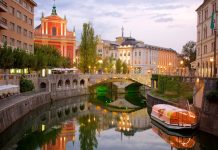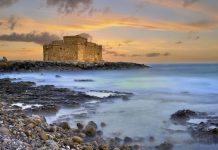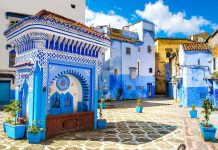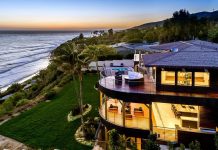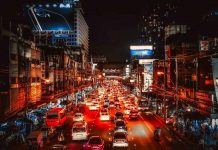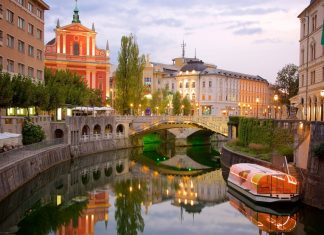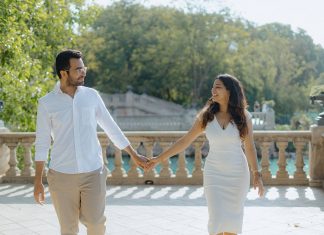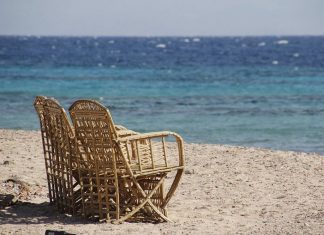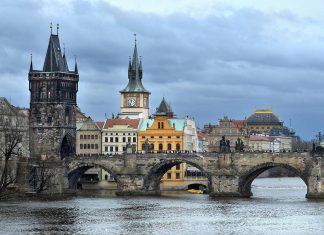Capri is an island of limestone rock that represents the outermost tip of the mountain chain on the Sorrentine peninsula. The coastline, whose dolomite cliffs fall right to the sea in many spots, is dotted with countless caves and surrounded by reefs whose shapes suggest fantastic creations.
Mount Tiberio (334 m.), to the east, and Mount Solaro (589 m.) to the west are the two main peaks on the island. Between these heights, on a saddle-shaped ridge connecting the Marina Grande, (Large Marina) – north end – and the Marina Piccola, (Small Marina) to the south – is the town of Capri (138 m.). The other town, Anacapri (286 m.), sits in the large, verdant plain to the west of Mount Solaro.
Capri contains a vast variety of plants and flowers, offering no fewer than 850 species and 130 varieties, despite its extremely small surface area, including some rarities, such as the dwarf palm, which has survived in a number of inaccessible areas. In terms of wildlife, many species of marine animals enrich the surrounding sea. On land, there are many types of non-migratory birds, such as the large diomedei gulls, and there are also reptiles, whose number includes the very rare lizard of the Faraglioni rocks.
The etymology of the name Capri must be traced back to the Greeks, the first colonists to populate the island in recorded time. This means that Capri was not derived from the Latin Capreae (goats), but rather the Greek Kapros (wild boar).
The numerous fossil remains of that animal found on Capri confirm that it was once the Island of the Wild Boars, and not the island of the Goats, as the Latin derivation would seem to indicate. Inhabited since the paleolithic age, when it was still attached to the mainland, the island later became Greek, and then Roman. After visiting Capri in 29 BC, Caesar Augustus was so taken with the islandls beauty that he bought it from the city of Naples, giving up the nearby island of Ischia – much larger – in return. Legend has it that his successor, Tiberius, who lived there from 27 to 37 AD, built twelve villas, dedicating them to the twelve gods of Olympus.
From the most magnificent of these dwellings, the Villa Jovis, he ruled the Roman Empire. Other emperors spent time in Capri, which was visited and inhabited by Roman nobles up through the IVth century AD.
Returned to the ownership of the Dutchy of Naples, the island was raided by the Saracens in the sixth and seventh centuries, and was dominated during various periods in the years that followed by the Longobards, the Normans, the Angevins, the Aragonese and, finally, the Spanish.
The island experienced a period of renewed good fortune in the 17th and 18th centuries, in coincidence with the great political and artistic upsurgence of Naples, and thanks to the existence of an active church diocese, as well as the privileges granted the island, first by the Spanish and then by the Bourbons. Evidence of this golden period is the stupendous architecture of the churches and convents built in the two towns.
Beginning in the second half of the 18th century, the island became a preferred destination of the Bourbons, who went there to hunt quayle and simply to travel. Many of the increasing number of visitors from the north who came to take in the magnificently primitive nature of the south included the island in their travel plans and gave the world its first images of Capri.
Unfortunately, their arrival also brought about the systematic plundering of the extensive Roman ruins, preserved almost intact throughout the centuries. As a result, a tremendously rich heritage was devastated and dispersed, so that today only a few traces remain. These are found primarily in the digs that are resumed at periodic intervals.
Starting in the first half of the last century, in the wake of the discovery of The Blue Grotto, or Blue Cave, the flow of Italian and foreign tourists began, being drawn to the island by the climate, the hospitality of the people and the colors and magnetic atmosphere of the various sites.Writers, painters, exiles, rich and eccentric visitors: from the end of the 1800’s until the Second World War, many chose the island as their year-round or seasonal residence, building villas and contributing to the creation of the multi-facetted, multi-lingual, cosmopolitan colony that made the name Capri famous and established the island’s myth.
Via Krupp
In 1900 the German magnate Krupp financed a street for travel by foot that joined the Quisisana, where he lived, to the Marina Piccola.
Built with admirable skill by the engineer Emilio Mayer, it has been called the world’s most beautiful road, thanks to the manner in which it hugs the rock and the appropriate use of local construction materials .
The Gardens of Augustus
These belonged to the villa of Friedrich Alfred Krupp, son of the founder of the great German steelworks, who took up residence in Capri towards the end of the last century.
Built on the ruins of ancient Roman structures, the gardens were donated by Krupp to the Town of Capri, which later named them for the Roman emperor. In a corner of the garden, a statue of Lenin by the sculptor Manzu was erected to commemorate his stay on the island.
Villa San Michele – Axel Munthe
The villa was built for the Swedish physician and writer Axel Munthe, author of the well-known novel The Story of San Michele. The construction involved transforming a simple country home and an old chapel dedicated to San Michele and originally built on exquisitely decorated ruins from the Augustan age that demonstrate the presence on that spot of a sumptuous residence.
The style of the imposing structure is very free, set in the middle of a large, well cared-for park. It is owned by the Swedish Munthe Foundation and is open to the public: many of the founder’s possessions, including rustic and antique furniture, as well as countless archaeological artefacts, are preserved in a charming atmosphere.
Villa Jovis
The island’s largest imperial villa, it was built for Tiberius at the beginning of the Ist century AD and discovered in the 1700’s under the Bourbon ruler Charles.
The first exploration took place in 1827; the dig was expanded in 1932-35 by A. Maiuri who brought to light much of the original structure, which covers 7,000 sq. meters; the gardens of the villa must have originally covered the entire hill.
The structure, built to an uncommon height, consisted of a number of different floors terraced along the natural slope of the land, with the difference from the highest to the lowest point being 40 m.


